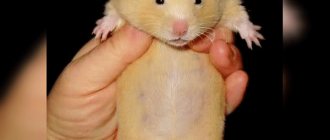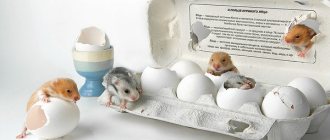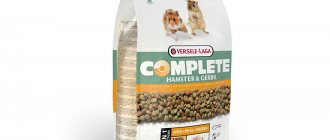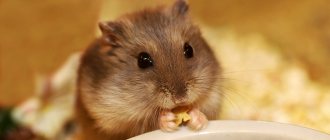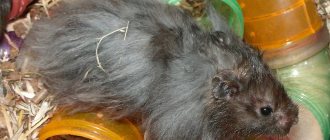09/12/2021 22 Hamsters
Author: Olga
For those who decide to start breeding Djungarian hamsters, it is not enough to just buy a couple of mature animals. Small rodents are able to reproduce all year round, but this process must be controlled. To regularly produce healthy litters, a potential breeder must understand when to mate rodents, how to tell if a female is carrying babies, and how birth occurs.
[Hide]
Puberty
Djungarian hamsters become sexually mature at the age of 1 month. The female begins her first heat and can already become pregnant. But this does not mean that you can start breeding. It is recommended to wait until the female finally matures - her body will become stronger and maternal instinct will appear.
The ideal age of a female for the first mating is from 3 to 6 months. But you can’t wait too long - the older the female, the less chance of getting healthy offspring and giving birth without complications.
If a female becomes pregnant immediately after puberty, there is a chance that she will subsequently eat the offspring due to undeveloped maternal instincts.
Many owners often keep different-sex dwarf dogs together all the time. But in this case, you should prepare for the constant appearance of offspring. In addition, hamsters of this breed do not really like their neighbors and often fight for territory.
Pairing
Djungarians need to be mated during the period when the female begins estrus. In other words, when she starts to "walk". This condition lasts from several hours to a day, and occurs approximately once a week. It is not difficult to notice - the female will begin to arch her back and raise her tail, while releasing a strong-smelling substance to attract the male. It is during this period that a male is placed with the hamster.
It is advisable to bring the male and female together in the evening, since at this time they are more active. You can’t leave Dzungarians alone right away. First you need to observe their behavior. If the female is not aggressive and shows favor towards the partner, they are left alone.
Sexual intercourse among Djungarians lasts about 1 minute. Until the female stops estrus, it is not advisable to seat the couple. To achieve a result, several acts must occur.
At the end of the mating season, the male must be placed in another cage. If you leave them together, then after the birth of the babies the male can destroy the offspring by fighting for territory. Or the female will destroy them, thus protecting them from the male.
We improve living conditions
If the animal’s cage is not equipped with an additional internal house or other “shelter” where the female can place her babies, you should take care of this immediately after the news of the upcoming replenishment.
You don't have to buy a house. The construction of the nest can be left to the hamster directly. She will happily arrange the “nursery” on her own
It is important to help her with building materials. All kinds of shreds and napkins (without aromatic additives) are perfect for this role.
The basis of the house can be a cardboard box of the appropriate size.
After the female has completed construction, touching the hamsters’ home is strictly prohibited. This ban lasts until the newborn reaches 2 weeks of age.
How to understand that a female is pregnant
Experienced hamster owners who have been breeding them for a long time know that fertilization of the female does not always occur the first time. Therefore, sometimes it is necessary to mate dzhungarikas several times.
Signs indicating a female is pregnant:
- Decreased activity.
- Increased appetite.
- Arrangement of the nest.
- Weight gain.
Usually for the first 7-10 days the hamster behaves as usual, and it is quite difficult to understand that she is pregnant. The main indicator is the absence of estrus. If the female does not start walking again a week after mating, she is most likely pregnant.
Sometimes a so-called “false pregnancy” occurs, when the behavior of a dzhungarik indicates pregnancy, but childbirth never occurs. In this case, the embryos can simply dissolve. This happens from stress. But in any case, if there is a false pregnancy, it is better to show your pet to a veterinarian.
Pregnancy in hamsters: how to determine how long it lasts and other questions
Hamsters are very cute, funny and unpretentious animals, which is why many people keep Djungarian or Syrian hamsters as pets. But if you are the happy owner of two opposite-sex hamsters that live in the same cage, or are planning to breed them, then we recommend reading this article, from which you will learn how to determine pregnancy in a hamster, what pregnant females of these cute animals look like, and also about rules for the care and maintenance of expectant mothers bearing offspring.
Caring for a pregnant female
All necessary conditions are created for a pregnant hamster. This applies to both content and diet.
Content
The dwarf and future offspring need more space, so they select a spacious cage. The air temperature in the room should be within +21-25°C. Care should be taken to ensure that the cage is not exposed to direct sunlight. Ladders, pipes, wheels and other toys are also removed so that the expectant mother does not inadvertently injure herself.
During pregnancy, the Djungarian hamster should be protected from stress:
- You should not pay too much attention to the female, so as not to disturb her again. Otherwise, she may regard this as a threat to the cubs and simply destroy them after birth;
- It is not recommended to touch a pregnant female so as not to leave her scent.
Feeding
During pregnancy, the Djungarian hamster must receive enhanced nutrition. However, you should not include unusual foods in your diet due to the risk of an allergic reaction or diarrhea. In order for the fruits to develop properly, you will need a lot of protein:
- nuts, seeds;
- dairy products;
- eggs;
- chicken meat.
The female is also fed vegetables, fruits, and sprouted herbs. During pregnancy, a hamster especially needs calcium. The deficiency is compensated with the help of tablets or crushed chalk.
We improve living conditions
A pregnant woman definitely needs a house or a nest.
If there is no house in the enclosure, then from the beginning of pregnancy you need to take care of the future nest and provide the hamster with a large number of soft, non-scented napkins and scraps of warm textiles; the animal itself is able to prepare a cozy sleeping place for itself.
Any suitable sized cardboard box will be suitable as a house or shelter. In the absence of a box, it is better to block the ceiling and side walls of the cage from the penetration of bright light. After building a nest, the hamster’s home is strictly forbidden to be touched until the cubs reach 2 weeks of age.
Preparing for childbirth
As for preparing for childbirth, the female begins to build a nest on her own. You can help her by putting soft paper, cloth or hay in her cage. Djungarik immediately uses them to build a nest for the babies.
It is forbidden to use newspapers or magazines containing printing ink - it is very harmful to children.
A few days before birth, the cage is cleaned. In this case, the house with the nest cannot be touched. It is enough to replace the filler, remove leftover food, and wash the feeder and drinking bowl. The cage can be moved to a quieter place where the female will not be disturbed by pets or household members.
Caring for the safety of babies
To prevent your pet from eating the babies, try to clean the cage in advance of the birth. After the babies are born, access to the hamster’s home should be limited as much as possible. Do not pick him up for communication, do not try to touch or stroke the offspring. All that is required of the owner is to carefully clean the toilet area and put food in the cage. Place the hamster's house in a quiet and calm place, eliminating the occurrence of anxiety. Several rules will help protect the cubs from the aggressive behavior of the female:
- try to minimize stressful situations;
- do not add other hamsters to the cage;
- provide the rodent with adequate nutrition;
- allow females to give birth between 4 and 12 months of age;
By providing the pet with favorable conditions during gestation and the feeding period, the likelihood of eating its own young can be reduced to zero.
The birth of the Djungarians
It is not difficult to make sure that a Djungarian hamster is about to give birth. The closer this moment is, the more passive the pregnant female becomes. She even stops eating, but drinks a lot of water. Therefore, it is important to ensure that there is always clean, fresh water in the cage.
When the time comes, it is advisable that there is no one in the room with the cage. It is not recommended to interfere with the natural process of giving birth to babies, especially if you lack experience.
On average, a Djungarian hamster gives birth to about 10 babies at once (the maximum number is 18 babies, and the minimum is 2-3). Childbirth lasts several hours. Moreover, each cub appears at intervals of 10-15 minutes.
Under no circumstances should you pick up a newborn baby; the foreign smell will make the female refuse them, or worse, she will eat them.
Half an hour after giving birth, the female feeds the babies milk and falls asleep. She needs to be provided with complete rest and protected from stress for 3-4 weeks. This is exactly what is required for the cubs to grow up and become independent.
Possible problems and complications
Djungarian hamsters often have health problems during pregnancy and childbirth:
- Toxicosis . It is extremely rare among Djungarians, but unlike people, it is dangerous for a pregnant female. In this case, toxicosis develops during childbirth and even after it. There is no treatment, so it is deadly for the mother (and often for the offspring).
- Pathologies of childbirth . Before mating hamsters, be sure to pay attention to their age. This is especially true for females older than one year. By this age, their pelvic organs lose elasticity, which makes it more difficult for them to give birth. If there are few cubs (2−3), then they are larger than usual. In such a situation, the only way to save the hamster and its offspring is through surgery.
- Fetal death . This is caused by an infection or genetic disease. To save the dwarf, you also cannot do without surgery.
- Endometritis . The first symptoms of the disease are bloody discharge with an unpleasant odor that does not stop for several days. This sign often indicates the presence of a dead fetus inside.
- Mastitis . Females feed their babies on their own, and often no problems arise. But if during lactation signs such as fever, redness and enlargement of the mammary glands, and loss of appetite are observed, this may indicate mastitis.
If any strange symptoms appear during pregnancy or childbirth, you need to show your Djungarian hamster to a veterinarian.
Caring for the female and offspring
Mother and cubs require special care. The cage should be in a quiet, dark place. For the first few weeks, it is better not to clean the cage and not touch the babies so that the hamster does not worry about the foreign smell. The male is not placed with them for several reasons:
- adults will fight for territory;
- the babies will interfere with a new mating, which will entail the destruction of the offspring by the male (and sometimes the female).
The cubs are born deaf, blind and naked. Hearing appears only on days 4-5, and vision - 14 days after birth. Babies gradually grow hair. At the age of 1 month they become sexually mature and can be given to new owners.
It happens that the female eats some of the cubs - in this way she destroys weak and sick babies. But sometimes the Djungarian hamster eats the entire litter - in case of severe stress, insufficient nutrition or the next pregnancy (to make room for new babies).
To prevent the death of babies, they are separated from their mother. But this cannot be done until they open their eyes. Two-week-old cubs will have to be fed on their own for some time. If the female behaves normally and does not show aggression towards them, then the offspring are separated by gender at the age of 3-4 weeks and placed separately.
At the age of 3-4 weeks, Djungarians are already quite capable of mating and becoming pregnant, so girls must be separated from boys.
Repeated pregnancy
The female Djungarian hamster is ready for mating within 1-2 weeks after birth. But it is better to wait 2-3 months until she fully restores her health. In addition, a quickly occurring new pregnancy of a dzhungarika will have a negative impact on the cubs, which are not yet ready for independent life.
Pregnancy and childbirth in Djungarian hamsters usually occur without complications. At the same time, the owner bears great responsibility for the health of the female and offspring. In addition to creating suitable conditions for the dwarf, you should take care in advance about who to give the cubs to.
Features of different breeds
The gestation period for different breeds of hamsters varies slightly, so you should study their characteristics in advance.
Syrian
Representatives of the Syrian breed develop aggression towards the male during pregnancy. The female will try to bite him and even kill him, so after mating the animals must be seated in different cages.
Djungarians and other dwarf hamsters
In Djungarians, aggressiveness does not arise so clearly, but experts still advise separating future parents.
Representatives of the Campbell breed can stay with the female and even help in raising the offspring.
